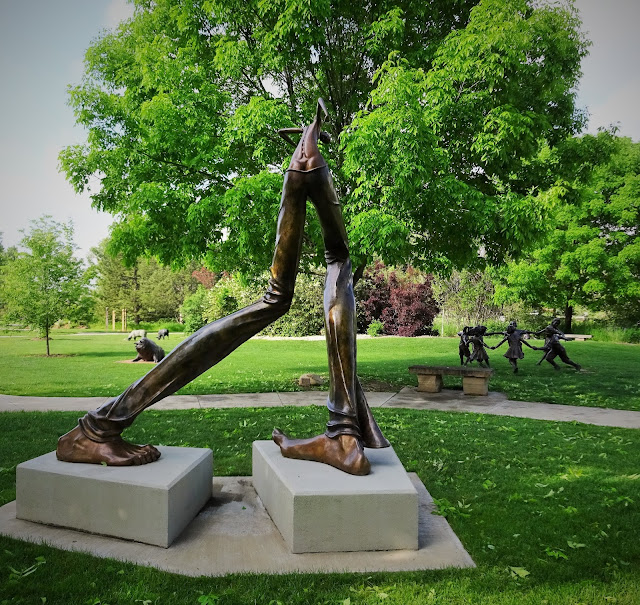Hans lived in Loveland, CO briefly in the early 1970's, when he was a youngster. His father, a creative entrepreneur, became involved in the art casting business which is how bronze sculptures are made. This ultimately lead the family to move to Grand Junction, CO where they ran a precision casting foundry, making high tech metal parts. As a teenager, Hans worked at a variety of jobs in the Grand Junction foundry.
Fast forward 40-some years to our brief stay in Loveland, CO. We drove past the house where Hans lived in 1971 - 1972 and also discovered that the foundry where his dad worked those many years ago offered tours.
Art Castings of Colorado is one of the largest art casting foundries in the US and they bring you right up to the action throughout the foundry, teaching about the "lost wax" process along the way.
Here's how a bronze or stainless steel sculpture is made...
An artist creates a sculpture, usually in clay or wax. A mold is made from the art piece by covering the original in liquid rubber, then applying plaster for support. Wax is poured into the mold and, when cool, the rubber is pulled off producing a hollow sculpture. The wax sculpture is cleaned up using a variety of tools to produce an exact duplicate of the original sculpture.
Next, wax gates, or sprues, are attached to the piece as avenues for the molten metal to flow into the piece. Then a ceramic shell is built up around the wax by repeated dippings into a slurry and coating the slurry with fine sand. The completed shell is kiln fired and the wax is melted (lost) from the shell.
Once the ceramic shell is emptied of wax, it is reheated to 1600 degrees and molten metal is poured in at about 2000 degrees. Once cooled, the ceramic shell is removed with a pneumatic hammer and extensive sandblasting is done. If it's a large piece, it is created in multiple parts and the parts must be welded together.
Many of the workers in the foundry are artists themselves, and it is evident in the detailed finishing work that must be done to get to the final finished product.
 |
| Wing molds. |
 |
| Here a worker pours wax into a mold |
 |
| In the Wax Chasing area the wax is made to look like the original. |
 |
| Ceramic shells are built up around the wax parts. |
 |
| In this kiln, the fired cermics are white (in front), and in the back are yellow ceramics ready to be fired. |
 |
Kendra tells us about the finishing process.
She is standing next to a piece of a giant horse being welded together. It will be about 30 feet high. |
 |
| Finishing booths. |
 |
| This is a mockup of the giant horse/Indian sculpture. |
 |
| Most of the large pieces here will be part of the giant horse and Indian sculpture. |
On the same day we walked through the lovely
Benson Sculpture Garden. The Benson family homesteaded the land in 1877 and in 1961 donated some of the family farm to the city to be used as a wetlands and bird habitat. In 1985 the sculpture garden was built around the wetlands, creating a beautiful, artisitc statement in the middle of the city, with 148 pieces of art on permanent display. Bronze sculptures can also been seen around town as a testament to the local art casting culture.
Walking the sculpture garden and the doing the foundry tour in one day was a perfect way to learn about and appreciate this unique form of art.

















Very interesting. Never really knew how those sculptures were made.
ReplyDeleteIt's pretty fascinating!
DeleteThis really is fascinating Lisa. I would love to do the tour. . Great combination with the sculptures in the wetlands. Too funny the long legs and the pants problem. Love the butterfly. What an interesting childhood Hans must have had. I hope you are gone from the Loveland area given the problems there that we are hearing about on the news.
ReplyDeleteWe leave in the morning. Fortunately the worst has just missed us. Though there is more ahead of us...
DeleteThose are two places we would enjoy visiting! I especially love outdoor sculpture gardens, and it's interesting to witness the process of creating them. Next time you're in Santa Fe, check out the Shidoni sculpture gardens and foundry. Interesting story about Hans and the foundry.
ReplyDeleteYes, any time you can see a mix of art and nature...priceless! Thanks for the Santa Fe tip.
DeleteHow delightful!
ReplyDeleteVery interesting story Lisa. Would love to see those gardens and take the tour.
ReplyDeleteWhat an interesting, informative, and beautiful post Lisa. Great job and pictures explaining how the sculptures are made and then sharing some you saw in the garden. Its always fun to learn things about the folks in the blogs we read...thanks for sharing!
ReplyDeleteNot sure how I missed this great post - I love sculptures and this was really interesting to see the process. It's amazing how detailed they can get with things like feathers! I couldn't pick a favorite in the garden, they're all wonderful.
ReplyDelete